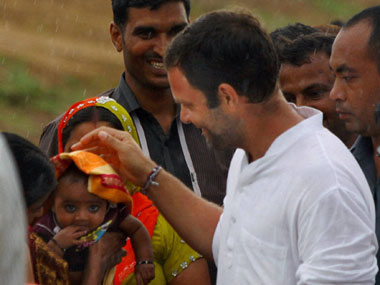By Sagarika Ghose Four days. Over 100 km. An energetic trek from Bhatta Parasaul to Aligarh. An NSG-encircled power walk. The white-clad, fair- skinned, rather well-built figure stomping across the muddy tracks of rural Uttar Pradesh, looked a little bit like a teenager in a huff angrily setting off to complain to the world about how badly grown-ups are behaving. But Rahul Gandhi is still a rebel without a cause. Yet the padyatra is an extremely powerful political phenomenon; sometimes it is the road to political salvation. The last national padyatra was staged by former PM Chandra Shekhar when he walked from Kanyakumari to Rajghat over 171 days in 1983. Like a stone from a sling, it catapulted Chandra Shekhar from political anonymity to political revival. Seven years later he was prime minister. The most dramatic padyatra in recent times was the one understaken by YS Rajasekhara Reddy in Andhra Pradesh in 2003. A year before the general elections, with Chandrababu Naidu hailed as the prince of Shining Andhra and coasting almost certainly to a massive win, Reddy literally blasted Naidu’s highway to victory by laying out his own tarmac of triumph. He walked across the length of the state in 64 days and covering 1,500 kilometres. Covering Reddy’s padyatra for the Indian Express, I saw first hand its immense power. Meeting people in their homes, in their parks, in their markets, in their villages, in their huts, holding public meetings at every streetcorner, Reddy’s mammoth walk galvanised party workers. A despondent demoralised Congress, crushed by Chandharababu Naidu’s towering cult, suddenly struggled to its feet with a new spring in its step. The poster boy of New Andhra found himself defeated by an old warhorse. The laptops and spreadsheets and powerpoint presentations of Team Naidu suddenly looked redundant by the sheer force of a direct visit to voters’ homes. Gandhian, arduous and populist, the padyatra is an umatched political device in the Indian context because, in villages and small towns, leaders are remote elitist figures smiling down from billboards. Rahul’s padytara could win hearts and minds in UP. It could revive the Congress cadres which are non- existent. In UP, the Congress is a drawing room party: its ‘leaders’ sit in cooler-blown scented drawing rooms, legs crossed on obligatory towel -covered sofas, shaking their feet in that curious side to side motion that politicians have perfected. Rahul may not be shaking his legs on sofas, but he’s still a will-o-the-wisp. Now you see him and now you don’t. He appears in Bhatta Parsaul and then suddenly disappears. He appears in Lakhimpur Kheri then disappears again. He seems like an event-oriented strategist, rather than a political activist with a cause. His events are pragmatic, designed for maximum effect, strategically planned, yet lacking in the key ingredient that marks out the genuine people’s leader from the political freelancer: a cause. A cause worth fighting for. A cause worth dying for. [caption id=“attachment_38981” align=“alignleft” width=“380” caption=“Rahul’s events are pragmatic, designed for maximum effect, strategically planned, yet lacking in a cause worth fighting for. PTI”]  [/caption] Rahul still lacks a big idea. In fact, he’s a politician in search of a big idea. Mamata Banerjee fought the Left, day after day, year after year, for over two decades. ‘Paribartan’, or change, was her mission. The cowherd Lalu Prasad Yadav smashed the barriers of upper caste power, and democratised society in Bihar by gatecrashing the Brahmin-Rajput club. Social justice was his fierce obsession day in and day out. The same burning ambition marked the rise of the BSP in UP: justice for the Bahujan Samaj in the face of elite scorn and discrimination was the single point thrust of battle. But what does Rahul stand for? What’s his cause? What’s the one message that voters will gravitate towards him for? Some 7 years since his political debut, we still don’t know. Rahul refuses to give interviews, refuses to speak on major issues and seems to open up only to American diplomats and British foreign secretaries. He’s told the American ambassador that Hindu terrorism is as much a threat as Islamic terror. He’s even taken David Milliband for a night stay in a Dalit home, which many saw as an offensive example of poverty tourism. Is our Indian “youth icon” bending over backwards to please visitors from aboard? He’s often said he understands the privileges of dynasty and is working to reduce its impact in the Congress. He’’s trying to fix the Youth Congress and National Students Union of India, although these efforts at organisational elections and finding new talent are not working quite as well as they should. Rahul’s candidates did poorly in the recent Kerala and Tamil Nadu assembly elections. In Bihar, where he campaigned extensively, the Congress won only 4 seats in last year’s assembly elections, leading Nitish Kumar to remark that a “youth icon” cannot be someone born with a silver spoon in a privileged family.  Rahul Gandhi is still an unknown quantity X. Still unsure of whether UP is his primary karmabhoomi or if being prime minister is his destiny. The ‘pro-poor’ identity may have worked for his grandmother but in an aspirational India it may be too limited. Rahul Gandhi is still an event manager, the CEO of the Youth Congress, the strategic planner with his secretive coterie of young men; yet strangely reluctant — unable perhaps — to throw himself at the people in a no-holds-barred embrace. Sagarika Ghose is Deputy Editor of CNN-IBN
Now you see him, now you don’t. Rahul Gandhi’s events are pragmatic, designed for maximum effect, but they lack a key ingredient that marks out a genuine people’s leader from a political freelancer: a cause, a big idea.
Advertisement
End of Article
Written by FP Archives
see more


)
)
)
)
)
)
)
)
)



